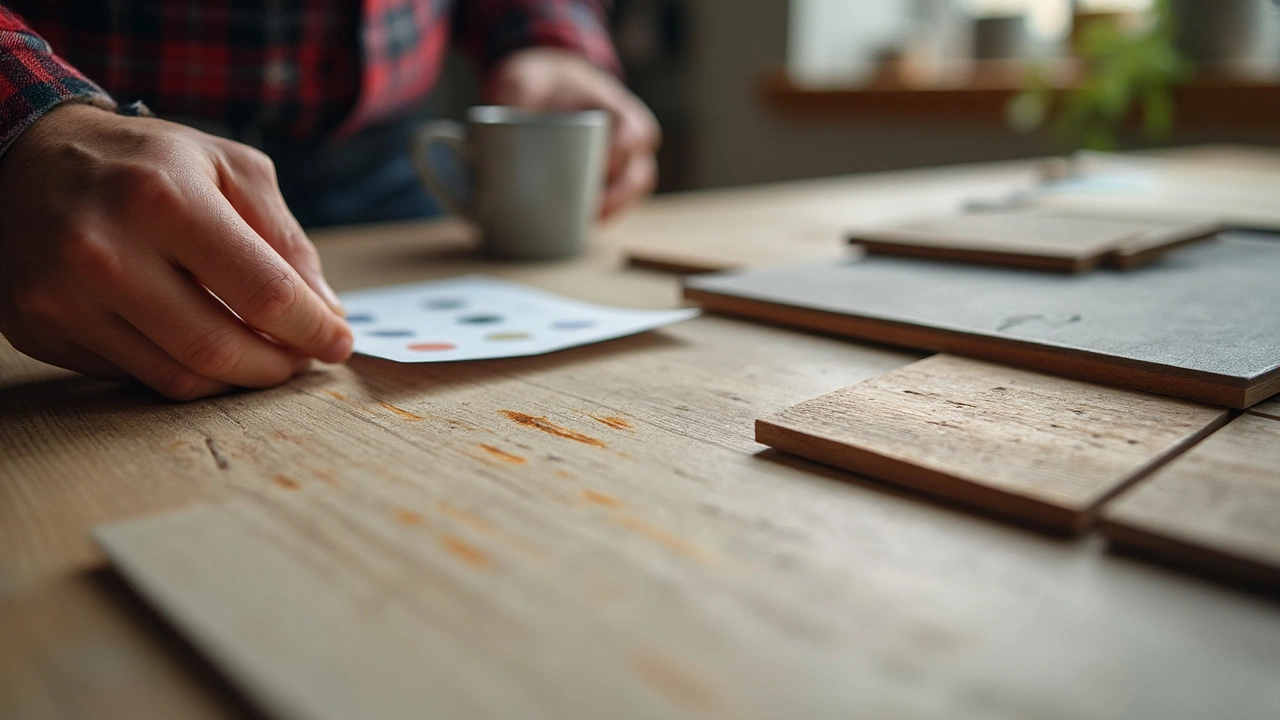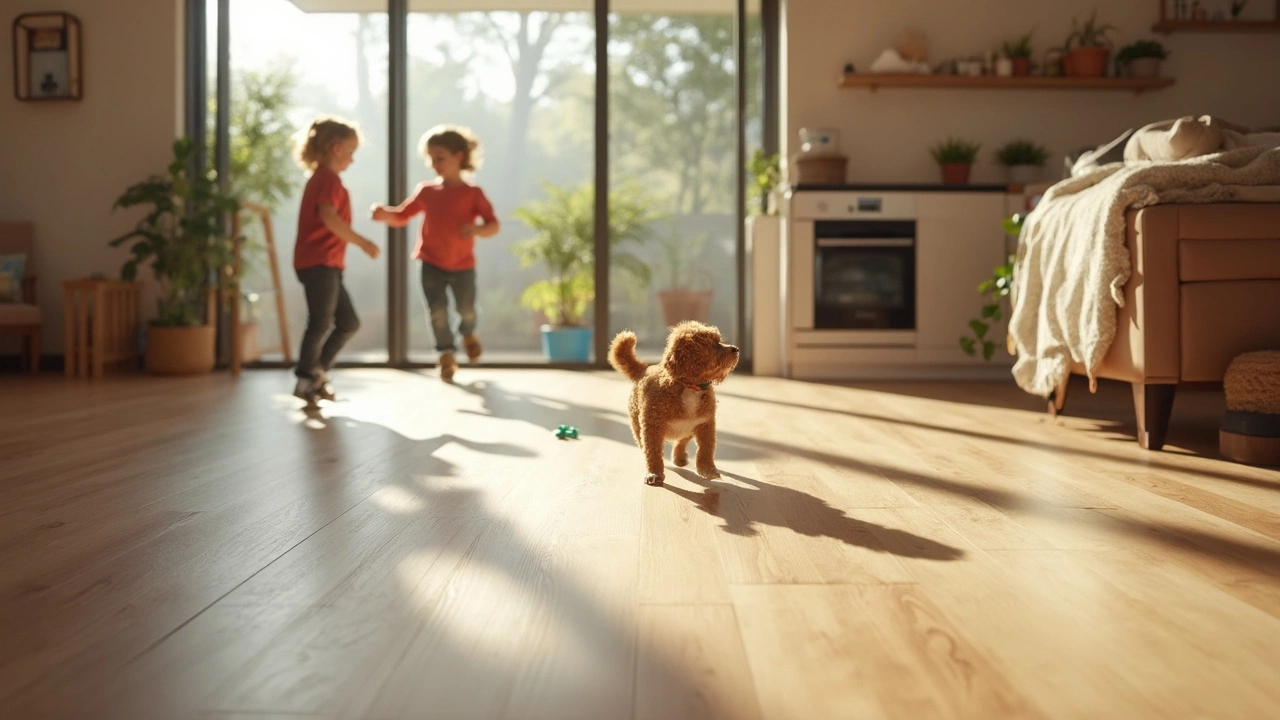Shoes off at the door? It’s not always enough. If you’ve ever watched your dog slide across the living room or your kid drop a metal toy, you know scratches can sneak up anywhere. So, when it comes to choosing flooring that truly resists marks, where do you even start?
Here’s the thing: not all scratch-resistant floors are created equal. Some are great for light traffic but fail when the dog goes zoomies. Others shrug off furniture slides like it’s nothing. Picking the right one depends on your home life, pets, and whether you mind a bit of maintenance.
This guide doesn’t sugarcoat—some floors just don’t hold up, no matter what the showroom says. I’ve run through the options, and I’ll spell out which floors actually survive the real stuff: pets, kids, clumsy adults, and heavy furniture. We’ll look at top picks, what makes them tough, plus simple things you can do to keep even the best floors looking fresh.
- What Makes Flooring Scratch-Resistant?
- Top Scratch-Resistant Flooring Types
- Smart Tips to Keep Floors Scratch-Free
- Real-Life Myths About Flooring Durability
What Makes Flooring Scratch-Resistant?
It’s easy to get lost in marketing terms like 'tough' or 'rugged.' But true scratch resistance comes down to what goes into the floor—and how it’s made. The best flooring that doesn't scratch is built with hard surfaces and strong finishes that stop sharp objects from digging in.
Here’s the recipe for scratch resistance:
- Material hardness: Some stuff, like porcelain tile or top-tier luxury vinyl planks, is just tough by nature. The Mohs scale (for tile) or Janka scale (for hardwood) shows you how much force it takes to scratch a material. The higher the number, the less you’ll stress over grit from shoes or scraping chairs.
- Protective finishes: Factory-applied coatings can toughen up wood, laminate, or vinyl. Think of this layer as the clear armor over your floor. Aluminum oxide, commonly used on hardwood, is famous for fighting marks from everyday use.
- Wear layers: With products like luxury vinyl, the printed layer sits below a clear, thick wear layer. Cheap floors have thin layers—for real-life durability, aim for 20 mil or higher, especially if you’ve got active pets or heavy foot traffic.
- Color and pattern: Floors with texture or pattern help hide light scratches. Matte finishes are less likely to show scuffs compared to glossy ones, which spotlight every mark.
- Care for installation: No surprise here, but a sloppy install can leave floors more likely to get scratched. Uneven boards or edges catch dirt and grit, which acts like sandpaper over time.
Real scratch resistance is all about these basics. Even with the above features, every floor has limits—dragging metal furniture, for example, will test anything. But if you’re looking for peace of mind and low-stress living, floors made with these traits will always outlast the knockoffs.
Top Scratch-Resistant Flooring Types
Walk into any flooring store and you’ll get hit with a million options—some look amazing, but not all of them can handle a busy life. Let’s break down which types of floors laugh at scratches and which ones only talk a big game.
Here are the main contenders if you want floors that don’t end up looking battered:
- Scratch-resistant flooring like luxury vinyl plank (LVP) and tile are absolute winners. LVP is made with a tough wear layer so claws, toys, and moving chairs barely leave a mark. Tile, especially porcelain, is even harder—drop a pan, you might break the pan before the tile.
- Engineered hardwood with an aluminum oxide finish is way better than old-school softwood. You get that wood look without the constant heart attack every time something falls.
- Laminates with AC4 or AC5 wear ratings were basically made for chaos. The rating means they’re actually tested for heavy abrasion. If your house feels like a playground, it’s a smart pick.
- Bamboo is underrated—strand-woven bamboo rates higher than red oak on the Janka hardness scale. That means dog nails and soccer shoes don’t faze it.
No flooring is invincible, but these make a huge difference in how much you have to worry about dents and lines. Here’s a side-by-side to give you a feel:
| Flooring Type | Scratch Resistance | Water Resistance | Looks Like | Maintenance |
|---|---|---|---|---|
| Luxury Vinyl Plank (LVP) | High | Excellent | Wood/Stone | Low |
| Porcelain Tile | Very High | Excellent | Tile | Low |
| Engineered Hardwood (Aluminum Oxide Finish) | Good | Okay | Wood | Medium |
| Laminate (AC4/AC5) | High | Good | Wood | Low |
| Strand-Woven Bamboo | High | Good | Bamboo/Wood | Low |
If you’re worried about kitchen spills or bathroom puddles messing up your floor as well, vinyl and tile are your best bet. For that classic wood look, engineered hardwood and laminate both hold up much better these days—just skip the super cheap options.
And one quick tip: always ask about the warranty on scratch-resistance. Some brands back up their claims; others are just selling the dream. It pays to read the fine print before you swipe your card.

Smart Tips to Keep Floors Scratch-Free
You’ve picked out scratch-resistant flooring, but even the toughest floors can get beat up if you’re not careful. Nobody wants to waste money on repairing or replacing floors. Here are practical ways to keep your floors looking new.
- Use rugs and runners: High-traffic spots like entryways and hallways will get scratched the most. Throw down a few rugs. It’s way cheaper to replace a rug than a whole floor.
- Felt pads are your friend: Put felt pads under chairs, tables, and anything else you move around. A 16-pack costs less than $10, but it saves you tons of frustration.
- Keep it clean: Small bits of dirt and sand act like sandpaper under shoes and paws. A quick sweep or vacuum every week goes a long way. For pets, keep their paws clean after walks.
- Mind your footwear: Surprisingly, high heels cause the worst dents and scratches—more than pet claws! Maybe set up a no-shoes rule or at least avoid heels indoors.
- Clip those claws: Regularly trim your dog’s or cat’s nails. Just five minutes with a pet clipper can prevent most marks.
If you’re curious just how much this stuff matters, here’s a fast breakdown of what people deal with in a busy home:
| Source of Scratches | % of Reported Floor Damage (Home Surveys, 2023) |
|---|---|
| Pet claws | 31% |
| Furniture movement | 24% |
| Dirt/grit tracked in | 18% |
| High heels/sharp shoes | 13% |
| Toys/sports gear | 10% |
| Other | 4% |
Wrap up with two habits: move heavy stuff carefully and don’t drag anything sharp across the floor. Even if you think your floor is bulletproof, a couch with metal legs or a dropped toolbox will test its limits fast. A couple of cheap tricks—like cardboard under heavy furniture—save a lot of pain later. Bottom line: most damage is preventable with a little planning and five minutes of prep.
Real-Life Myths About Flooring Durability
Shopping for new floors? You’ll hear all sorts of claims from salespeople and websites. Not all of them hold up in day-to-day life. Let’s call out some of the myths that trip up most homeowners.
Scratch-resistant flooring isn’t the same as scratch-proof flooring. This may sound obvious, but people get burned by the difference all the time. Even floors advertised as ultra-durable—like luxury vinyl or high-end laminate—will show marks with enough pressure or repeated abuse. That sleek laminate in the appliance store won’t look the same after your dog skids across it a few dozen times.
Bamboo is often labeled as super tough. Technically, strand-woven bamboo does score high for hardness, but not all bamboo products are created equal. Cheaper bamboo scratches faster than you’d expect. You have to look for the high-density, strand-woven stuff if you want serious durability.
Tile seems indestructible, right? Sure, porcelain and ceramic don’t scratch easily, but grout is a whole other story. Grout lines can stain or chip way before the actual tile does. Also, drop a heavy pot, and your “scratch-resistant” floor might chip or crack. Always consider what kind of abuse your floor will face.
Solid hardwood gets points for beauty, but people think refinishing means it lasts forever. In reality, hardwood is pretty easy to scratch. Pointy heels, pet claws, or dragging a chair can leave their mark. You can sand out scratches a few times, but each refinish thins your boards.
Check out how different floors stack up when it comes to everyday use:
| Flooring Type | Scratch Resistance | Can Be Refinished? | Biggest Weakness |
|---|---|---|---|
| Luxury Vinyl Plank | High | No | Deep gouges are permanent |
| Laminate | Medium-High | No | Water damage, deep chips |
| Strand-Woven Bamboo | High | Yes, but carefully | Low-quality versions scratch easily |
| Porcelain Tile | Very High | No | Chips, grout stains |
| Solid Hardwood | Medium | Yes | Scratches, dents |
And here’s a fun one: just because a floor survives a metal key or a high-heeled shoe in demos doesn’t mean it will look new forever. Everyday dirt, sand, and toys are the real enemies. They grind away at your finish little by little. That’s why regular cleaning and using rugs in high-traffic spots matter way more than the ads let on.
